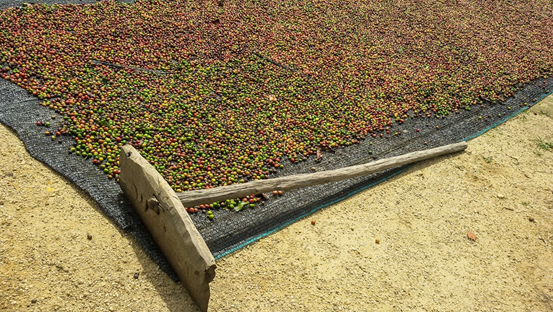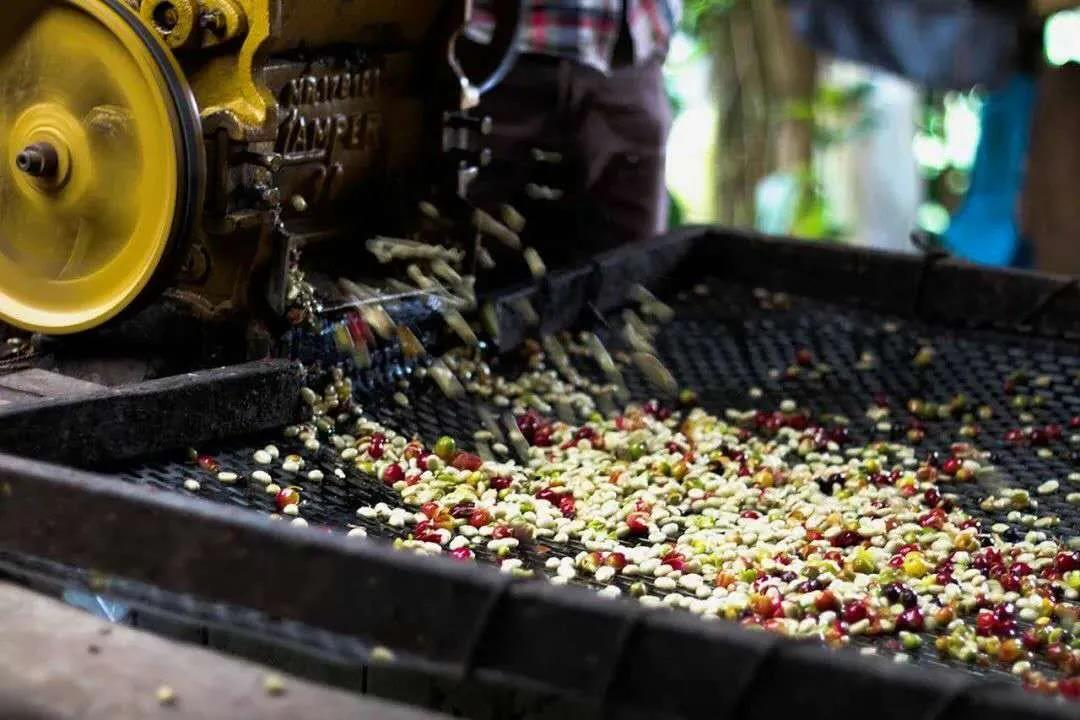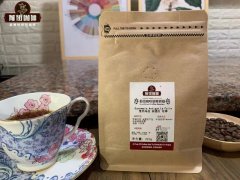Where does the sugar in sun-dried coffee beans come from? why are sun-dried beans sweeter than washed coffee beans?
The same kind of coffee beans, different treatment, the flavor and taste will be different, and the sun and water washing, if it is the same bean, the sun coffee beans will be sweeter than water washed beans, the taste will be more rich.
The characteristic of beans in the sun is that the beans are naturally dried in the pulp, so the climate affects the quality of the beans. The color of sun-dried beans is yellow, and the bean body is prone to missing corners, which is inevitable when the shell machine knocks off the hard pulp and sheep skin at one time.
Sun and water washing
If the coffee beans with yellow color are handled properly, the essence of fructose will be absorbed in the drying process, the fruit aroma is rich, the sweet feeling is also heavy, and the pure thickness is also better than that of washed or semi-washed beans, but the sour taste of sun-dried beans is relatively low.
Water washing is the most popular treatment method at present. Almost all of Central and South America except Brazil, the color of washed beans is blue and green, the appearance of beans is neat and good, and the quality of coffee is high. Generally speaking, the sour flavor and bright feeling of washed beans are better, and the flavor is clean and free of miscellaneous flavor, which is commonly used in the treatment of fine beans.

Sugar content of sun-cured coffee
The sugar in coffee beans is mainly sucrose, accounting for about 5-9% of the seeds and more than 90% of the total sugar content.
The content of sucrose in coffee does not change with the processing method, but depends on the way the coffee is grown. However, sun-treated coffee beans do contain more fructose and glucose than fully washed coffee beans, while honey-treated coffee beans contain somewhere in between.
The contents of fructose and glucose in untreated coffee beans are also higher than those in washed coffee.

Bean sugar in washed coffee
As part of the washing process, raw beans need to be soaked in water for a period of time, and early studies have shown that sugar can be dissolved in water. But at the same time, other changes will also occur in mechanically washed coffee beans and drying beds, so water cannot be the culprit.
Instead, the researchers found that coffee seeds begin to germinate during washing. The process of germination first consumes the sugar stored in the seeds, starting with the monosaccharides (glucose and fructose) in coffee.
While affecting the level of sucrose, the germination of washed coffee also increased the concentration of some amino acids in seeds. Amino acids are one of the most important substances in raw beans that bring aroma to coffee, so it contributes to the complexity of aroma in washed coffee.
What makes the sun treatment sweet?
Although it is now clear that almost no sugar penetrates into the seeds during the treatment of raw beans, some compounds are indeed absorbed into the seeds. These are not the aroma of the fruit itself, but the volatile compounds produced by some microbes, especially esters, when the fruit begins to ferment.
Unlike the volatiles found in most raw beans before treatment, these compounds survive the roasting process and bring flower and fruit aromas to roasted coffee beans. Some of these esters, such as butyric acid and ethyl ester, also help our taste buds perceive sweetness.
Although most of the sugars themselves are destroyed during baking, they produce many aroma molecules during caramelization.
Important Notice :
前街咖啡 FrontStreet Coffee has moved to new addredd:
FrontStreet Coffee Address: 315,Donghua East Road,GuangZhou
Tel:020 38364473
- Prev

Guangzhou Community Coffee Shop recommends Guangzhou Coffee refined Community Coffee Shop
Professional coffee knowledge exchange more coffee bean information please follow the coffee workshop (Wechat official account cafe_style) guide today we have an online cloud sign-in. Maybe there's one right below your house! -37Coffee-37 first Street, Dongyi New District, Panyu District, Guangzhou City, Monday to Saturday 08:00-18:30 Sunday 09:00-19:00 37Coffee stationed at Panyu Square
- Next

Where does the aroma of coffee come from? why does fine coffee smell better than drink?
Most of the time, when you brew coffee and test coffee in the Qianjie coffee factory, you will feel the fragrance of flowers and fruits in the air, or the smell of caramel, sugar, honey and so on. When a hot cup of coffee enters the mouth, it doesn't have the wonderful feeling it smells like, or to put it bluntly, it's not as mellow as it smells. If you want to solve this mystery, you have to
Related
- What brand of black coffee is the most authentic and delicious? what are the characteristics of the flavor of the authentic Rose Summer Black Coffee?
- Introduction to the principle and characteristics of the correct use of mocha pot A detailed course of mocha pot brewing coffee is described in five steps.
- Which is better, decaf or regular coffee? how is decaf made?
- How much is a bag of four cat coffee?
- How about four Cat Coffee or Nestle Coffee? why is it a cheap scam?
- Which is better, Yunnan four Cats Coffee or Nestle Coffee? How about cat coffee? is it a fake scam? why is it so cheap?
- How about Cat Coffee? what grade is a hoax? which instant coffee tastes better, four Cat Coffee, Nestle Coffee or G7 coffee?
- Process flow chart of coffee making-Starbucks coffee making process what coffee tastes good at Starbucks
- The top ten best coffee beans in the world Rose summer coffee or Tanzanian coffee tastes good
- Yunnan four cat coffee is good to drink?_four cat coffee is a big brand? four cat blue mountain coffee is fake?

